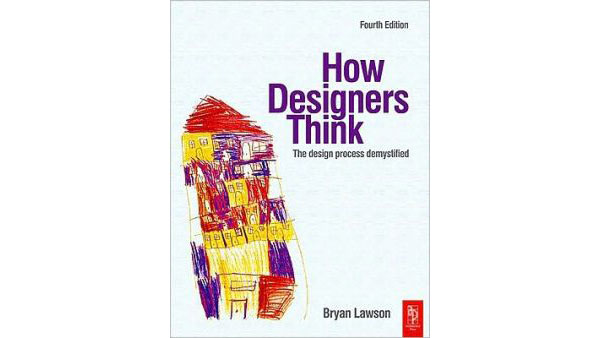
Author: Bryan Lawson (Routledge, 4th ed., 2005)
Designers of any discipline consistently struggle to define their “process”: a way to break down the challenges posed, question them, and develop solutions, accordingly. Each profession will tackle this goal differently, and within their given subset of design, will take a different path to their ultimate product: an exercise that brings us the variety of fascinating designs we see us today from architecture to coffee makers. The mystery around the design process has intrigued many people for years and in How Designers Think: The Design Process Demystified, Bryan Lawson goes far beyond attempting to simply map this process out. This book is an inescapable climb into the psyche of a designer, to probe the depths of how they solve problems, and discover methods which work better than others.
The book is laid out in three Parts, with several sub-sections. Part one asks the question, What is Design?, and as we discover through this section, the concept of design is not easily defined. This is followed by Problems and Solutions, that focused more specifically on actual challenges a designer faces in day-to-day work. The final Part, Design Thinking, highlights creative thinking in general, looking at tactics and traps which designers face. The book is logically sound, laid out in arguably one of the only possible ways to clearly allow the reader to go beyond simple understanding of the concepts and see methods of implication based on a solidly rooted scientific, psychological, and philosophical foundation.
As one would expect, Lawson speaks highly of designers and their seemingly nebulous way of thinking. There is a constant reference to the fact that designers must finely balance scientific and analytical thinking with concerns around beauty and aesthetics. A tough task. Lawson discusses these topics in a very accessible way, highlighting the cognitive aspects of design through the eyes of a psychologist stating that the “cognitive theorists approach to thinking is…attractive to those who seek to understand the design process because it draws many parallels between thought and perception.” The depth of the psychological profile that Lawson shares with the reader is thorough and proportionately well researched, allowing it to flow without sounding at all pretentious.
Lawson also touches upon specific types of thinking—the main one he associates with designers being “solution-focused design.” Accordingly, one of Lawson’s eloquent statements really struck a cord with me. He describes that “in general the design process needs to be more balanced and almost by definition less focused than some polemical work might require.” Based on personal experience, the high pace, expectations, and complexity of current practice fosters a design culture that cannot comprehensively understand the issues they are for, or worse yet, a lack of curiosity towards a deeper understanding because of lack of time or budget. This ultimately leads to haphazard design solutions. The practice of balancing parallel thought processes—analytical and aesthetic, theoretical and practical—is the essence of the design process and one of its most empowering aspects. If this mode of thinking were encouraged more frequently, designers could contribute much more positively to the world today.
Another section that truly hit home for me looked at Design Tactics, where he quotes well-known American architect Denise Scott Brown as stating that “you have to accommodate more complexity and confront more political options in planning than in architecture.” In response, Lawson’s states that overall “the idea that there is a hierarchy of design problems with town planning at the top, architecture in the middle and product design at the bottom has limited value.” He goes on to explore this idea, attempting to prove that with respect to thinking processes—of “problem-focused design,” as he calls it—these hierarchies are non-existent since each design discipline carries their own load of problems to solve through many different facets. While some may feel that there is a pecking order of respect for certain professions over another, Lawson reveals that this is beside the point when discussing thought processes.
From start to finish I was fascinated by Lawson’s description of the design process in How Designers Think, and while there was a little bit of redundancy throughout, he was always able to bring the issues back to a strong level of clarity. There is no set path to beautiful design, and as designers we are always moving forward, looking for the next problem to solve. Lawson reminds us, however, that taking the time to engage the issues comprehensively leads to more well-rounded, and ultimately better finished products. As such, developing a solid set of foundation skills and methods are of the utmost importance, permeating into other work and yielding stronger results.
How Designers Think: The Design Process Demystified is a definite read for anyone in the design profession, and in my humble opinion, should be mandated as a required reading in all design-related classrooms.
***
Jeremy Senko is happily lost in the world of theoretical architecture and design. He is forever a student at heart, consistently reading, experiencing and learning about the world he inhabits. More specifically, he recently completed his Bachelor of Interior Design at Kwantlen Polytechnic University, where he pushed the limits (and the patience) of his professors.

